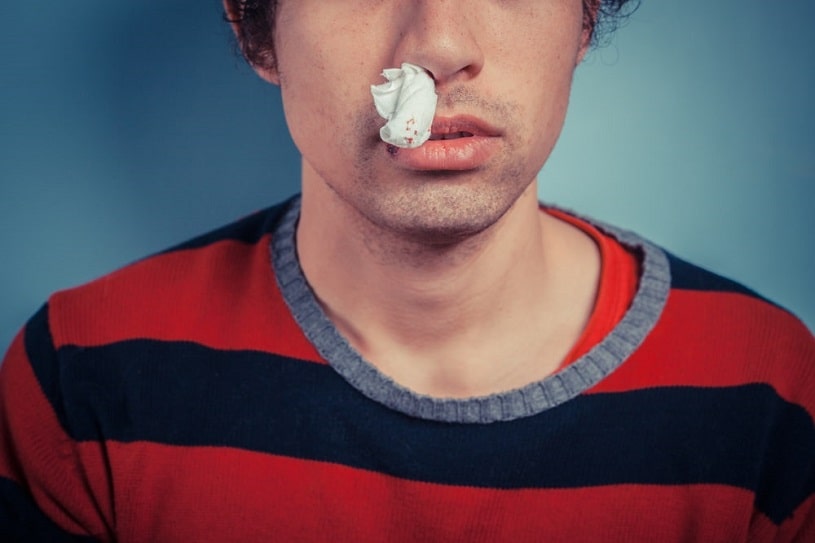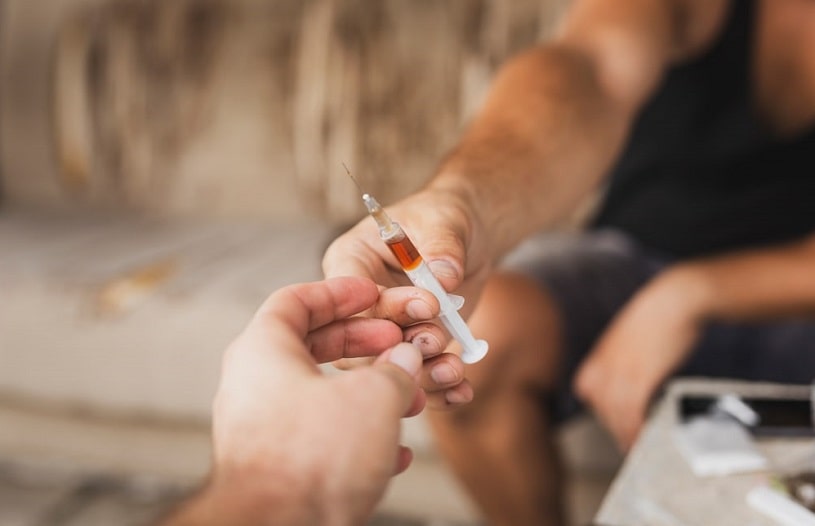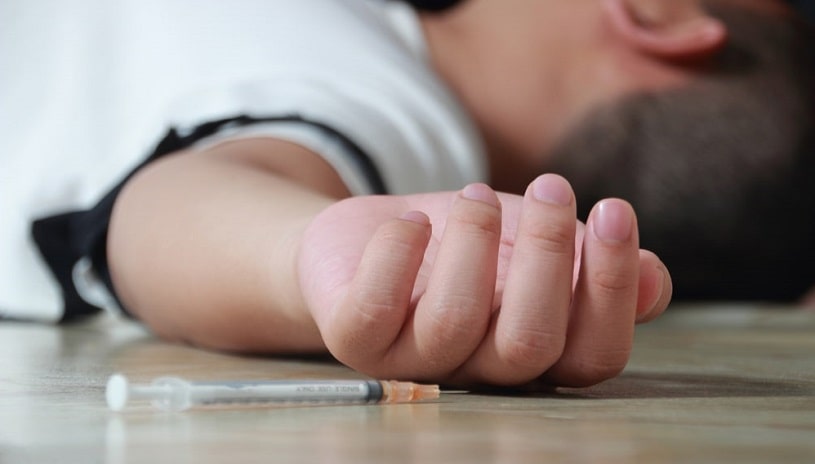Heroin is an illegal drug that can cause fatal complications when overdosed. It is a highly addictive form of opioid that causes people to have an urge to continue using the drug, often leading to an overdose. After cocaine and marijuana, this is the third drug leading to emergency intervention.
Table Of Contents:
- What Are the Risks of Snorting, Smoking, and Injecting this Drug?
- What are The Overdose Symptoms?
- Which Factors Can Cause an OD?
- Does it Affect The Body and Brain?
- How Much Does it Take to OD?
- Can One Die From Heroin Overdose?
- What To Do In Case Of An Overdose?
- What are the Most Helpful Medications?

Statistics show an increase of over 500% in deaths caused by heroin overdose were noted between 2010 and 2016. In 2016 alone, more than 15,000 deaths were recorded that were linked to an overdose of heroin – this data is reported by the CDC and only accounts for the United States.
Almost 948,000 individuals in the country reported using some form of this drug in 2016. There is a great concern to educate the population about an overdose’s possible complications. Understanding the risks of various ways people abuse this drug, as well as knowing what to do in the case of taking too much opioid, is crucial.
Dangers of Snorting, Smoking, and Injecting Heroin
Addicts use to smoke, inject, or snort heroin for the intense surge of euphoria it produces. This is followed by a state of altered consciousness or being “out of it.” So, is one method of administration more dangerous than others?
Risks of Snorting Heroin
In addition to the short-term effects of abuse, administration of this substance can lead to a number of long-term health problems, including difficulty breathing. Extended use can lead to liver and kidney disease, skin infections, lung complications, and blood vessel collapse.
In addition to the risks and complications mentioned above, there are many specific of them related to snorting heroin, including:
- Nosebleeds
- Breathing problems
- Sinusitis
- Loss of smell sense
- Asthma
- Infections such as hepatitis C
- Damage to the nasal mucosa, septum, and sinuses
- Perforation of the nasal septum
Recognizing Signs of Snorting Heroin
How can one recognize that someone is using snorted heroin? Some specific physical signs can indicate that a person might be using an illicit substance by insufflation:
- Runny nose
- Constant sniffling
- Frequent nosebleeds
- Recurrent nose infections or sinus problems
- One-sided nasal inflammation
- A hole in the nasal septum (the wall between the two nostrils)
Other red flags include things such as residues of brown or white powder on furniture, rolled up pieces of paper with a unique smell, and straws or other paraphernalia of drug use.
Dangers of Smoking Heroin
Ultimately, no method of ingesting heroin is safe. When it comes to comparing injecting and smoking, it is not a matter of one being safer than the other, but rather that there is a trade-off of risks. Without needle sharing, there is less likelihood of contracting certain illnesses, such as HIV and hepatitis.
Other problems are more likely to develop, as well. For example, a study found links between smoking heroin and brain degeneration, leading to devastating neurological ailments. Users also experience illnesses related to the lungs that are not caused by the injection, such as asthma, COPD, and lung cancer.
Heroin overdose from smoking is possible. Smoking heroin effects also release certain chemicals in the body; and addiction can develop quickly.
Signs That Someone Is Smoking Heroin
The first thing to do is keep an eye out for signs that the potential user behaves differently from time to time. Then look for other signs of using the drug in general, such as heroin teeth, that can be spotted. From there, keep an eye out for signs specifically associated with smoking to figure out if someone is consuming the drug in this manner, and if noticed, consider requesting a heroin drug test.
Red Flags of “Chasing the Dragon” are:
- The smell of the Drug. What does heroin smell like when smoked? It will depend on the type used. For example, black tar tends to smell heavily of vinegar since it is used in the production process, while purer forms carry a similar but less potent scent.
- Masking Smells. Addicts know that the smell can give them away; they are likely to try to mask the scent. This may mean wearing too much perfume, changing clothes seemingly without reason, and using deodorizing sprays.
- Slang. Addicts often use specific lingo related to their habit, which means that loved ones should know its nicknames in general and for smoking it specifically. One key phrase for smoking heroin is chasing the dragon.
- Visual Evidence. What does heroin look like when smoked? Once it is smoked, there really is no visible evidence of the drug left. What can be seen, however, is the paraphernalia used to smoke it. Smoking on the foil is the most common method of smoking, so seeing foil in the trash or packets of foil could indicate a problem. Cigarette papers, glass tubes, and glass pipes may also be used. Finally, loved ones can also look for the packaging the drug comes in—either plastic baggies or balloons in most cases.
If any of these signs are noticed, attempt to confirm the drug use and then seek treatment for addicts. Do not attempt recovery at home as the heroin relapse rate without assistance is high.
What are the Health Risks of Shooting Heroin?
While shooting up increases the risk of a heroin overdose or toxic symptoms, it also increases the risk of certain complications, particularly infections, resulting from shooting it.
There are Four Main Ways Heroin Injections Can Cause Infections:
- Incorrect injection of the drug
- Use of shared injected equipment
- Unsterilized techniques
- Injecting contaminated drug
Diseases Associated with Incorrect Insertion of the Needle
Some users may incorrectly insert the needle into a pulse or an artery. This is associated with a high risk of occluding the artery, causing gangrene of the part of the limb supplied by the artery. This is a serious complication because it may necessitate amputation of the limb.
Heroin injection sites chosen by the user may also increase one’s risk of incorrectly shooting the drug. For instance, attempting to take a heroin shot through the groin may lead to incorrect insertion of the needle into the large artery or nerve, which lies side by side with the vein. This could lead to abscesses and bleeding from damaging the artery.
Diseases Associated with Use of Shared Injection Equipment
Using shared equipment to inject the drug can transmit certain blood-borne infections, such as hepatitis C, hepatitis B, and HIV.
| Disease | Risks |
|---|---|
| Hepatitis C | Hepatitis C is a virus that infects and damages the liver. It often presents with upper abdominal pain, yellowness of the eye, recurrent fever, and weight loss. However, most infected persons may not show any signs or symptoms until the lover has been badly damaged.
Hepatitis C is mostly spread by intravenous use, with more than 90% of the disease caused by injecting heroin and other intravenous substance use worldwide. In the United States, approximately 30,000 new cases of hepatitis C occur every year, with only about 2,000 manifesting symptoms. |
| Hepatitis B | Hepatitis B is another virus that infects and damages the liver. It may also be transmitted by exposure to blood and body fluids of an infected person. Therefore, sharing needles poses a high risk of contracting the disease. |
| HIV | HIV can be contracted by exposure to blood or genital fluids of an infected person. Using shared heroin needles, therefore, places an individual in contact with blood from an infected person. It can also be spread through sexual intercourse, blood transfusions, and vaginal birth.
About 30% of HIV infections worldwide (outside sub-Saharan Africa) are caused by using shared needles. |
| Other | Other diseases that can be transmitted via shared injection equipment include malaria and human T-lymphotropic virus (HTLV). HTLV is known to cause a type of cancer known as adult T-cell leukemia/lymphoma.
While overdose complications are mainly treated with replacement opioid therapy and psychotherapy in inpatient addiction treatment centers, these infections require intense antibiotic therapy. |
Diseases Associated with Lack of Sterile Technique
Using unsterilized equipment may cause several infections. Sterile injection involves using injection equipment that has been heating at high temperatures to remove contaminants and germs. It also involves cleaning the heroin injection site with an antiseptic solution to prevent the introduction of bacteria and other germs from the skin into the bloodstream.
Many users engage in unsterilized practices of shooting the drug, inserting contaminated unsterile heroin needles into the veins in an unsterile environment.
Methicillin-Resistant Staphylococcus Aureus
One common bacterial agent spread due to the use of unsterile techniques is methicillin-resistant Staphylococcus aureus (MRSA). Other infectious agents such as streptococci can also be spread in this way.
These bacteria commonly begin by infecting the tissues beneath the skin of the heroin injection site, causing cellulitis, furuncles (or boils), abscesses. It may then progress to infecting deeper tissues and bones, causing necrotizing fasciitis, septic arthritis, and osteomyelitis. The infection could spread into the blood to different organs, leading to sepsis.
Consequently, the bacteria may seed into the heart, liver, and even brain, causing severe infections.
Group A Beta-hemolytic Streptococci (GABHS)
Group A Streptococci can also be transmitted by shooting the drug in unsterile conditions. It infects the body through direct contact with the skin or mucous membranes from contaminated objects, such as heroin needles.
Group A streptococci cause common infections, including non-invasive conditions such as scarlet fever and impetigoб and invasive and severe infections such as bacteremia, toxic shock syndrome, and necrotizing fasciitis.
Diseases Caused by Heroin Contaminants
Contaminated heroin shots may cause several infections and diseases. In a hospital setting, medications for injection are injected in their pure and sterile forms. However, for drug users, substances may be mixed or cut with other substances and micro-organisms, which can cause infections.
What is heroin cut with? Some of these substances include caffeine, starch, sucrose, talcum powder, rat poison, laundry detergent, crushed painkillers, and baking soda. These substances are used to dilute the drug, but some of them can be dangerous.
Bacterial spores could contaminate some of these substances, causing certain infections, such as botulism and tetanus, when the drug is shot up.
Botulism-Contaminated Heroin
Botulism is caused by Clostridium botulinum, which may occur in spores. These spores contaminate heroin and, when injected, can cause wounds at the heroin injection sites and botulism, which presents with weakness, blurred vision, weak muscles – manifesting as drooping eyelids, difficulty speaking, and difficulty swallowing.
Tetanus and Smack Needles
Tetanus is caused by Clostridium tetani, commonly found in the soil and rusty or dirty objects. Tetanus spores can also contaminate heroin, and this could take place at any point, from the production of the drug to its injection.
More than 15% of tetanus cases in the United States are caused by intravenous drug use, especially heroin injections. The disease presents with severe muscle spasms and convulsions.
Heroin Overdose Symptoms
Heroin overdose symptoms can vary due to many factors. They include the amount of the drug, the purity of the substance, the user’s age, and their physical condition. The type of heroin may also be a contributing factor – such as whether the liquid heroin or powder-based heroin was used. Of course, the usage of other drugs is very important. It is among the first things they investigate.
Some of the Most Common Signs are:
- Shallow breathing
- Constricted pupils, often referred to as heroin pupils
- Disorientation
- Confusion
- Delirium
- Drowsiness
- Loss of consciousness
- Coma
- Low blood pressure
- Stomach pain
- Dry mouth
- Pale face
- Purple lips
- Nausea and vomiting
Factors That Cause Heroin Overdose
The main factors that can induce OD are:
- One’s unawareness of amount of the injected substance, when a heroin needle and liquid form is used for the administration of the drug.
- The combination of this drug with other CNS depressants.
- One study by the Department of Veterans Affairs Medical Center in Ohio, published in the HHS Public Access Journal found that men are more likely to overdose on heroin than women.
- Individuals who had previously suffered an OD are also more likely to overdose again.
- Following abstinence from the drug, a relapse could also greatly increase the likelihood of overdosing.
- The study by the Department of Veterans Affairs Medical Center in Ohio also suggested that previously being arrested or incarcerated also makes a person more likely to suffer this state in the future.
Heroin Overdose Affects The Body and Brain
This state has a negative impact on almost every organ in one’s body. Furthermore, death often occurs due to the depression of the respiratory system. Additionally, heroin also lowers one’s blood pressure, which can lead to heart failure.
Arrhythmia is another major issue of a heroin overdose. Due to irregular heartbeat, organs can’t receive enough oxygen. This causes serious tissue damage. As a result, this can lead to pulmonary edema. The cause of this disease is fluid retention in the alveoli. As a result, it causes difficulties with breathing.
Needless to say, this thing can cause serious brain damage. Brain impairment often happens due to lack of oxygen and head injury. Brain damage due to a heroin OD is like Alzheimer’s disease. Also, depending on the severity of the overdose, this heroin side effect may be irreversible. Brain damage can also lead to a host of conditions. They include tremors, cognitive impairment, vision problems, memory issues, concentration issues, and seizures.
How Much Heroin It Takes to Overdose
The amount of heroin that can cause an overdose varies. Of course, it depends on many factors. They include one’s physical condition, age, height, weight, the way of taking the drug. Also, the use of other drugs or alcohol is also important. According to sources, the lethal dose of heroin is about 30 mg.
Heroin Overdose Death
Despite the fact that the number of border patrol agents has increased to approximately twenty thousand, and heroin trafficking and seizure arrests have increased by 50% between 2010 and 2015, mostly near the southwestern border; statistics show an alarming increase of overdose-related deaths in the last 15 years.
Respiratory Depression
Most of the deaths happen because of breathing problems. As said before, heroin depresses breathing and blood pressure. That can be very dangerous if a person is sleeping. In a normal case, our body knows how to breathe while sleeping, but that is not the case during an overdose.
Heart Failure
Another cause of death when it comes to a heroin overdose is heart failure.
Drug Interactions
Some longtime heroin addicts tend to combine this drug with other opiates with alcohol. As a result, it intensifies overdose effects. The morbidity rate associated with polydrug use has skyrocketed in recent years. The heroin-fentanyl combination has become one of the most deadly among addicted individuals.
Heroin Overdose Response
- When a person overdoses on heroin, one of the first steps to take is to dial 911 and to ask for emergency assistance immediately. Treatment needs to be implemented as soon as possible.
- Since the opioid overdose can be fatal, it is important to notify the appropriate medical emergency team so that they can send out an ambulance.
- If the person is taken to the emergency room without the use of an ambulance, calling in advance to notify of a heroin overdose will allow the doctor to prepare the appropriate equipment and medicine to treat the patient at the facility faster.
- The person who might have taken too much of the drug should ideally be placed in a position that is comfortable until further medical assistance can be provided to them.
- Another important step for anyone close to the individual who had administered too much of the drug to take is to administer the patient with a shot of naloxone as soon as possible following the overdose (if available). Naloxone is a drug that is used to inhibit the effects that opioids have in the body, which can help to reduce the harmful effects of the drug in the case of an overdose.
Heroin Overdose Medications
Statistics say that the most frequent emergency hospital visitors are between 21-24 years old, with 266.1 visits per 100,000. What help can they find in a hospital?
Evzio is currently one of the only prescription medications that have been FDA approved to be used at home in the case of an opioid overdose emergency. It acts as a heroin overdose antidote but only provides temporary relief. Even though this drug will not be a replacement for actual emergency medical care, it can help to reduce symptoms and increase the patient’s likeliness to survive the condition. Medical care may also be able to care for the patient and thoroughly treat the heroin overdose easier. The injector delivers a 2mg dose of naloxone into the patient’s bloodstream to temporarily counteract the effects of the heroin.
Narcan Nasal Spray is another option that is useful for individuals with close friends or family members who are known to have heroin-related problems. In the case of an overdose, the drug can be administered through the patient’s nasal passage and will help to temporarily inhibit the effects that the heroin has, reducing the symptoms that the patient is experiencing due to the overdose. Narcan Nasal Spray delivers a dose of 4mg naloxone.
Heroin Addiction Treatment is the Way to Prevent Overdose
Different treatment approaches for drug addiction and overdoses have been established. With opioid overdose, they will base the treatment of this event on life support and tracking life signs. The medical staff will conduct a blood and urine test to detect every substance the person took. Breathing support is also needed because the patient is unable to breathe on their own.
One of the most common medicines they use in OD treatment is Naloxone HCI. It can slow down and lessen the negative effects of an overdose. Then, the doctor will look for any sign or symptom of pulmonary edema or endocarditis. They are the most common complications linked to abuse. When they have stabilized the patient, the doctor will suggest inpatient rehabilitation.
If someone one knows is suffering from heroin addiction, then it is important to seek help before it is too late. Call a free drug hotline to receive counseling and further instructions on how one can help a friend or family member get the drug addiction rehabilitation help they need to overcome their addiction.
Page Sources
- CDC, Heroin Overdose Data, https://www.cdc.gov/drugoverdose/data/heroin.html
- Christine M. Wilder, Shannon C. Miller, Elizabeth Tiffany, Theresa Winhusen, Erin L. Winstanley, Michael D. Stein, Risk factors for opioid overdose and awareness of overdose risk among veterans prescribed chronic opioids for addiction or pain, 2016, https://www.ncbi.nlm.nih.gov/pmc/articles/PMC4751580/
- FDA, Evzio (naloxone auto-injector) Approved to Reverse Opioid Overdose, https://www.fda.gov/drugs/postmarket-drug-safety-information-patients-and-providers/evzio-naloxone-auto-injector-approved-reverse-opioid-overdose
- NIDA, What can be done for a heroin overdose?, https://www.drugabuse.gov/publications/research-reports/heroin/what-can-be-done-for-heroin-overdose
- Drug-Free World Foundation, THE TRUTH ABOUT FENTANYL, https://www.drugfreeworld.org/newsletter/issue13/the-truth-about-fentanyl.html
- WHO, Opioid overdose, https://www.who.int/news-room/fact-sheets/detail/opioid-overdose
- NIDA. What are the immediate (short-term) effects of heroin use?. https://www.drugabuse.gov/publications/research-reports/heroin/what-are-immediate-short-term-effects-heroin-use
- WHO, Global HIV, Hepatitis and STIs Programme, https://www.who.int/teams/global-hiv-hepatitis-and-stis-programmes/populations/people-who-use-drugs
- Paul P Walker, Erica Thwaite, Suzanne Amin, John M Curtis, Peter M A Calverley, The Association Between Heroin Inhalation and Early Onset Emphysema, 2015, https://pubmed.ncbi.nlm.nih.gov/26020453/
- Dedsy Yajaira Berbesi-FernándezI , Angela Maria Segura-CardonaI , Liliana Patricia Montoya-VelezI , Alexandra Ángel Santamaría, Use of injected heroin and risk of hepatitis C in three cities in Colombia, https://www.scielosp.org/pdf/rbepid/2017.v20n3/435-444/en









